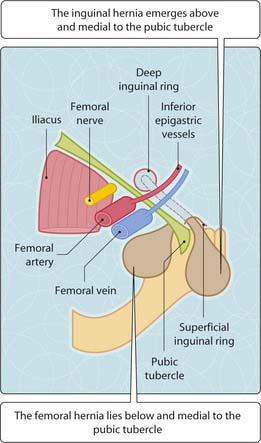5 Hernias
A hernia is an abnormal protrusion usually of a viscus through its containing cavity wall (Fig. 3.5.1). Abdominal hernias are formed from peritoneum and may contain loops of bowel. The four most common types of hernia in adults are inguinal, femoral, umbilical and incisional.
Types of hernia
Inguinal hernias
Inguinal hernias (direct and indirect) occur above and medial to the pubic tubercle (Fig. 3.5.2) and are more common in men. An indirect inguinal hernia arises through the deep ring, passes down the inguinal canal and protrudes through the superficial ring. It can be controlled by finger pressure over the deep ring (Ch. 33). These hernias result from congenital defects, regardless of age. A direct inguinal hernia arises straight through a defect in the posterior wall and then protrudes into the inguinal canal. These cannot be controlled by pressure over the deep ring. They result from weaknesses in the abdominal wall and are, therefore, more common in older patients. A scrotal hernia is an indirect inguinal hernia that continues down through the spermatic cord into the scrotum. A pantaloon hernia occurs when indirect and direct hernia occur together and are seen to ‘straddle’ the inferior epigastric vessels.
< div class='tao-gold-member'>
Stay updated, free articles. Join our Telegram channel

Full access? Get Clinical Tree











